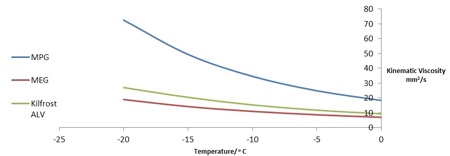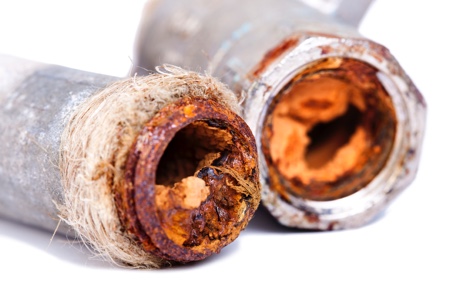The higher heat capacity and thermal conductivity of glycol-based heat transfer fluids makes them far more efficient in terms of heat transfer than non-aqueous alternatives. This has the effect of reducing overall energy consumption, thereby lowering both carbon dioxide emissions and long-term financial costs. In addition, the high biodegradability and low bioaccumulation potential of aqueous-based heat transfer fluids give them a superior environmental profile to non-aqueous-based equivalents.
It is well understood that glycol/water mixtures (commonly referred to as antifreeze) are inherently corrosive and the use of simple commodity chemicals, like glycols, as heat transfer fluids can lead to significant issues, such as corrosion and fouling of processing equipment, resulting in increased downtime and, in some cases, expensive repairs and replacements.
Within the pharmaceutical industry, downtime can be extremely costly and must be avoided wherever possible. What is less commonly known is that there are heat transfer fluids, with an inhibited glycol base, formulated specifically for either heating or cooling processes. Inhibited glycol/water mixtures make excellent heat transfer fluids for heating and cooling systems in comparison with oil and synthetic-based fluids.
Dramatic advances
Corrosion inhibition of glycol-based heat transfer fluids has advanced dramatically over the past 20 years, with the use of toxic chromates, nitrites and borates, as well as environmentally harmful phosphates and nitrates in decline.
Advanced, fully inhibited glycol-based heat transfer fluids will include long-lasting organic corrosion inhibitors based on a combination of long and short chained carboxylic acid salts, heterocyclic compounds and polymers. Furthermore, reputable companies will also opt to meet a demanding standard with respect to corrosion control.
An international test created by the American Society for Testing and Materials (ASTM), known as the ASTM D1384-05 corrosion test standard, is playing an increasingly important role, as the pharmaceutical industry begins to recognise the huge challenges that system corrosion can cause. The test is used to assess the impact of heat transfer fluids on systems. Under laboratory conditions, pieces of metal that are typically used in heating and cooling systems within the pharmaceutical industry, such as aluminium, iron, steel, brass, solder and copper, are weighed before being immersed in an aerated inhibited glycol/water mixture at 88°C. At the end of the two-week test, the metal is weighed again and analysed for signs of corrosion (see Figure 1).
Efficiency versus toxicity
A variety of glycol-based fluids are used within heat transfer fluid formulations. The most commonly used glycol bases are mono ethylene glycol (MEG) and mono propylene glycol (MPG). Both of these base fluids have different thermo-physical properties and, of prime consideration for the pharmaceutical industry, very different toxicity profiles.
Due to their high efficiency, inhibited MEG-based heat transfer fluids are widely and successfully used in heating and cooling systems around the world and are an excellent choice for numerous applications. The major limitation of MEG-based heat transfer fluids is the high mammalian toxicity of MEG itself. Due to this toxicity, any heat transfer fluid containing MEG poses a risk to human health when used in a system where incidental contact with items intended for human consumption is possible.
Heat transfer fluids based on MPG have, for many years, been the ‘go-to’ glycol for use in systems within the pharmaceutical industry, where impact on human health is a concern
Heat transfer fluids based on MPG have, for many years, been the ‘go-to’ glycol for use in systems within the pharmaceutical industry, where impact on human health is a concern. The mammalian toxicity of MPG is very low, meaning it is used as a key ingredient in products destined for human consumption, such as electronic cigarettes and pharmaceuticals, and is classified as ‘generally regarded as safe’ (GRAS) for most applications. Although MPG is far more favourable in terms of its toxicity profile, it is far less efficient at transferring heat energy, particularly at low circulation temperatures. The inferior efficiency of MPG is due to its higher viscosity, which increases pressure drops and, in many cases, makes the attainment of efficient turbulent flow unfeasible (see Figure 2). As a consequence, the use of MPG based products will lead to higher overall investment and operating costs.
As the chart (Figure 2) shows, a significant rise in circulating viscosity is to be expected on selecting a lower toxicity MPG-based product rather than a toxic MEG-based product. The difference in viscosity and overall system efficiency becomes even larger as the circulating temperature of the fluid decreases. To provide the industry with an advanced lower viscosity, low toxicity, ASTM-D1384-05 rated heat transfer fluid, Kilfrost ALV has been developed. With Kilfrost ALV a performance much closer to that of MEG-based products and a safety profile similar to MPG-based products can both be achieved, removing the need for any compromise on safety or performance.

Figure 2: Kinematic viscosity of heat transfer fluids formulated for use down to -30°C
The environmental profile of heat transfer fluids is also a very important consideration. An ever increasing number of companies are looking for sustainable options to replace petroleum-derived speciality chemical products, like heat transfer fluids. An opportunity has therefore arisen to develop practical and efficient alternatives for processing systems within the pharmaceutical industry.
Current bio-derived heat transfer fluids formulated with a sustainable chemical feedstock have struggled to make a significant impact in the glycol-based heat transfer fluid market as they offer no significant additional advantages aside from their green credentials. However, Kilfrost ALV offers better performance than existing products, while also making use of available bio-derived feedstocks.
Installation
In addition to selecting a quality glycol-based heat transfer fluid, best practice with respect to installation is also critical. Installing an efficient, well inhibited glycol-based heat transfer fluid into a contaminated system is self-defeating. To remove existing scale, sludge and biological contamination, systems should be cleaned and sanitised prior to the installation of any heat transfer fluid. To maximise the chances of long-term service and high system efficiency, on-site fluid testing is also strongly encouraged.
No matter how well a product is formulated, incorrect installation at the incorrect dilution or into an already contaminated system can lead to issues with fluid degradation and corrosion. Early detection of such problems will prevent damage to the operating system.

The pharma industry is beginning to recognise the huge challenges that system corrosion can cause
With the growing demand for low toxicity heat transfer fluids, alongside the ever-increasing desire for fluids that boost system efficiency, it is not always easy to find a heat transfer fluid that meets the needs of businesses. However, Kilfrost ALV fluid removes the need for compromise, providing a toxicologically harmless heat transfer fluid that offers higher system efficiency than products already on the market. ALV, therefore, could drastically improve the safety and efficiency of heating and cooling systems within the pharmaceutical industry.




